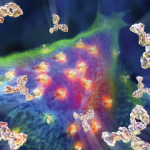ACPAs
The presence of citrullinated proteins in the extracellular matrix is theoretically what ultimately leads to the presence of ACPAs. Antigen-presenting cells presumably encounter such peptides and may process and present them to T cells, ultimately leading to antibody formation by B cells.6 It is important to note that ACPAs describe a group of antibodies that do not have exactly the same epitope targets, though they may share some cross-
reactivity, with a single antibody recognizing multiple citrullinated peptides.
Much work has focused on teasing out how these autoantibodies might contribute to the pathophysiology of rheumatoid arthritis. Notes Dr. Fox, “The strong association with RA—that makes people think that it’s directly involved in the pathogenesis.”
However, he also says the situation is complex, and we are just beginning to tease it out: “There are scenarios in which anti-citrullinated containing antibodies could be proinflammatory or anti-inflammatory, and probably, both are true, depending upon the specific citrullinated protein you are talking about and maybe even where on the protein it is citrullinated.”
It appears both citrullination itself and the formation of ACPAs may contribute to inflammatory processes relevant to RA. ACPAs can augment joint inflammation by engaging Fc receptors and forming immune complexes in the joint.
Dr. Fox also describes another association of ACPAs that bind to citrullinated vimentin on osteoclasts. “Dr. George Schett and others have observed that [ACPAs] directly activate osteoclasts, which are the bone eating cells. It is known that patients with RA, even before they develop RA, have low bone mass. The thought is that this antibody can be weakening the bone at all points in RA, even before there is any apparent arthritis detectable in the patient.”10
ACPAs also appear to provide an important pathophysiological link between known risk factors and the ultimate development of rheumatoid arthritis. For example, smoking is associated with RA and is a risk factor for the disease.
Antigens recognized by ACPAs can be created in inflamed organs or tissues in RA patients before the joints themselves become inflamed. As Dr. Fox explains, “Smoking causes protein citrullination in the lungs. The citrullinated proteins are the antigens that give rise to the [ACPAs], and the [ACPAs] are detected in fluid that you can get from the lungs even before it can be detected in the blood. The implication is that the whole process can start in an organ like the lung.”9 Something similar may apply to periodontal disease, which has a higher incidence in people with RA.
The development of serologically detectable ACPAs and RFs typically predates the onset of symptoms in those who develop seropositive rheumatoid arthritis (patients positive for ACPAs, RFs or both). This occurs three to five years, on average, before the disease becomes clinically apparent, although not all of these patients go on to develop RA. This phase is marked by increases in various cytokines and chemokines. Production of ACPAs locally in the mucosa may identify sites in the body that first show an inflammation-related autoimmune response in individuals who later display fully developed rheumatoid arthritis.9

